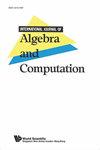群图编织群的分解
IF 0.5
2区 数学
Q3 MATHEMATICS
International Journal of Algebra and Computation
Pub Date : 2022-09-08
DOI:10.1142/S0218196723500583
引用次数: 0
摘要
我们提供了一种显式构造,允许人们容易地将图编织群分解为群的图。这使我们能够计算各种图的编织群,并为图编织群作为非平凡的自由积分裂提供了两个通用标准,回答了Genevois的两个问题。我们还用它来区分某些直角Artin群和图编织群。此外,我们提供了一个图编织群的显式例子,该图编织群相对双曲,但相对于适当子图的编织群不是双曲的。这否定地回答了热纳瓦瓦的另一个问题。本文章由计算机程序翻译,如有差异,请以英文原文为准。
Graph of groups decompositions of graph braid groups
We provide an explicit construction that allows one to easily decompose a graph braid group as a graph of groups. This allows us to compute the braid groups of a wide range of graphs, as well as providing two general criteria for a graph braid group to split as a non-trivial free product, answering two questions of Genevois. We also use this to distinguish certain right-angled Artin groups and graph braid groups. Additionally, we provide an explicit example of a graph braid group that is relatively hyperbolic, but is not hyperbolic relative to braid groups of proper subgraphs. This answers another question of Genevois in the negative.
求助全文
通过发布文献求助,成功后即可免费获取论文全文。
去求助
来源期刊
CiteScore
1.20
自引率
12.50%
发文量
66
审稿时长
6-12 weeks
期刊介绍:
The International Journal of Algebra and Computation publishes high quality original research papers in combinatorial, algorithmic and computational aspects of algebra (including combinatorial and geometric group theory and semigroup theory, algorithmic aspects of universal algebra, computational and algorithmic commutative algebra, probabilistic models related to algebraic structures, random algebraic structures), and gives a preference to papers in the areas of mathematics represented by the editorial board.

 求助内容:
求助内容: 应助结果提醒方式:
应助结果提醒方式:


